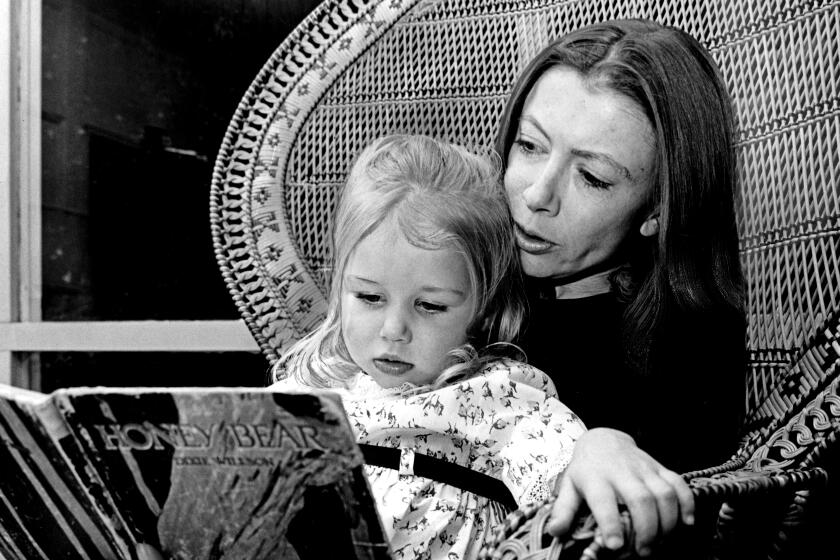Pharaoh’s Favorite
- Share via
In the pyramids at Giza, the stories of Pharaoh and Moses in the Bible, the “histories” of Herodotus, the liaison between the Egyptian queen Cleopatra and the Roman general Marc Antony and in the tales of the other Antony, St. Antony, the first Christian to seek God in the solitude of the Egyptian desert, ancient Egypt seems always to have been part of the West’s memory of the past. But there was another Egypt, the Egypt of Akhenaten, Pharaoh Amenophis IV, who lived in the 14th century BC and who was responsible for one of the boldest religious revolutions in history.
Akhenaten was a monotheist in a world of many gods, a political leader who abolished the gods of Egyptian religion and established the worship of the god of light, Aton. This chapter in Egyptian history had to be discovered because it was not part of the historical record. Shortly after Akhenaten’s death, his name was removed from the list of kings, his monuments obliterated, his inscriptions destroyed. For centuries no one knew of his existence. Only in the 19th century, through the work of historians, philosophers and archeologists, was evidence of his extraordinary accomplishments uncovered. How Akhenaten became part of our memory of the past is the subject of Jan Assmann’s fascinating new book.
“Moses the Egyptian” is not a conventional historical work. Though Assmann is an Egyptologist at the University of Heidelberg, his is not a historical account of the reign of the Egyptian pharaoh Akhenaten, though it provides enough information for the reader to learn the basic facts of Akhenaten’s religious revolution. Rather, one will find here an investigation of “the history of Europe’s remembering Egypt.” Assmann’s term for this is “mnemohistory,” a way of studying the past that is concerned “not with the past as such, but only with the past as it is remembered.” Though it should be said that Assmann, in a book that delves into aspects of European thought, cannot resist offering “Egyptological remarks” along the way, for example, on why Egyptian hieroglyphs kept their pictorial character.
In our culture Egypt is understood differently than China, India or the Incas. For when the West came to learn about these civilizations, through travel and archeological investigations, it had no previous knowledge of them. They were not part of our historical record, hence did not form our memory of the past. But when Egyptology as a historical discipline began to set down roots in the Renaissance, the West already had an image of Egypt. Egypt was a land of idolatry, and Moses was a Hebrew who had led his people out of this alien land to the promised land. In the wake of the Renaissance, scholars “discovered,” that is, began to re-imagine Moses as an Egyptian and also to consider the religious world that existed before his time and, it was opined, had formed his religious outlook. In their view, this more ancient Egypt was the origin of much of what the Bible presents as distinctly Jewish--for example, biblical laws.
“Moses the Egyptian” is a reference to the creation of an “Egyptian Moses” by scholars and religious thinkers over the last several centuries. Within the world of biblical religion, and thus of Judaism and Christianity, Egypt was viewed as “other,” hence there was no place for “Moses the Egyptian.” But since the Renaissance and the discovery of certain ancient Egyptian religious texts, it seemed plausible to see Moses as an Egyptian or at least as someone schooled in Egyptian wisdom.
The book tells the story of how Moses the Egyptian was depicted by writers on Egypt from John Spencer and Ralph Cudworth in the 17th century to Sigmund Freud in the 20th century--with stops along the way to discuss John Toland, William Warburton, Mozart (“The Magic Flute”) and Friedrich Schiller, among others. The evidence for Moses as an Egyptian trained in Egyptian wisdom was found in unexpected places, for example in Acts (7:22) in the New Testament (though not in Exodus in the Pentateuch) and in Philo of Alexandria’s “Life of Moses.” Freud drew on Exodus 11:3, “the man Moses,” for the subtitle to the German version of his book on Moses. He called it “Der Mann Moses und die monotheistische Religion,” in which the term “man” (mann in German) is an allusion to the Egyptian Moses.
Yet there is a deeper and more provocative theme here. Assmann has a strong religious, almost theological, interest, and he explores the difference between ancient Egyptian religion in its monotheistic form, what he calls cosmotheism, and religions of revelation such as Christianity and Judaism. He calls this difference the “Mosaic distinction” which crops up in phrases such as Israel and Egypt, Jew and Gentile, Christian and pagan, Muslim and nonbeliever. The religion of Akhenaten was short-lived. It did not take root, give birth to any tradition and, most significantly, draw a line between its new practices and the old idolatrous ways of Egypt. Indeed, in the ancient sources of cosmotheism, discovered only in the 19th century, the older Egyptian tradition that was rejected is never mentioned. It is as though what had come earlier had never existed.
How different with Judaism, Christianity and Islam. In the Hebrew Bible the tradition that preceded the religion of Pharaoh and the Egyptians, or of the Canaanites, is an essential part of the biblical narrative. The new is set against the old. “Mosaic monotheism is an explicit counter-religion which depends on the preservation of what it opposes for its own definition,” Assmann writes. What held true for Judaism is also true for Christianity and Islam. Christians call the Jewish Scriptures the Old Testament (which remains part of the Christian Bible) and Muslims call the period before Muhammad al-Jahiliyyah, the “time of ignorance.” Truth comes by way of revelation, and there is no natural or evolutionary way to move from the old to the new, one reason why Judaism has been such a challenge to Christianity. The “old” continues to live on seemingly oblivious to the fact of the new. (In an aside, Assmann says that he hopes his book will “contribute to a historical analysis of anti-Semitism.”)
“Moses the Egyptian” is a book of great learning, historical savvy and keen insight as well as a cornucopia of fascinating information. But Assmann is also a penetrating critic of the hidden preconceptions that drive even the most scientific and sophisticated historical scholarship. What the scholars and philosophers presented when they described ancient Egyptian religion changed as the spiritual climate altered. Moses learned to speak the language of Spinoza, Deism, pantheism, “natural religion” or Freemasonry, depending on what religious sensibilities were in vogue. It is a feature of historical scholarship in religion that is no less apparent today than it was 200 years ago.
More to Read
Sign up for our Book Club newsletter
Get the latest news, events and more from the Los Angeles Times Book Club, and help us get L.A. reading and talking.
You may occasionally receive promotional content from the Los Angeles Times.









